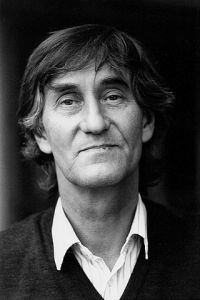Nils Udo is a Bavarian artist that has been working with nature as his main inspiration since 1972. Though he originally began by painting nature, Nils Udo eventually turned to creating site-specific pieces using natural materials. His artworks have appeared all over the world, including Europe, Japan, Israel, India and Mexico.
“By elevating the natural space to a work of art, I had opened myself to reality, to the liveliness of nature – I had overcome the gap between art and life. The roundabout way of two-dimensional abstraction in painting had been overcome. Henceforth my pictures were no longer painted, but planted, watered, mowed, or fenced.”
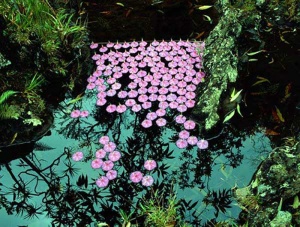
Bindweed flowers held in their journey on a stream by a stick dam. Reunion, Indian Ocean, 1990
He works on site using found berries, leaves, sticks, the movement of water, and the growth of plants. Each piece is in response to the landscape and materials he finds around him. Nil Udo uses many different ways to create line, whether it be the materials he uses, the placement, or implied lines.
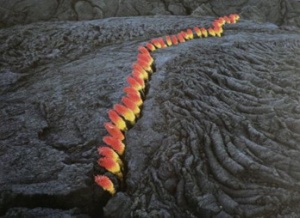 Lava flames–flowers & lava flow, Reunion, India
Lava flames–flowers & lava flow, Reunion, India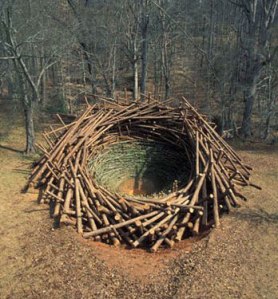 Nest in red clay, Clemson College, 2005
Nest in red clay, Clemson College, 2005
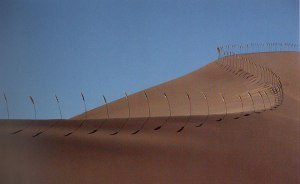 Dune Edge: pampas grass, sand, wind –Namibia, 2001
Dune Edge: pampas grass, sand, wind –Namibia, 2001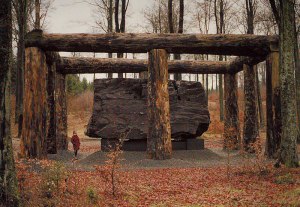 STONE-TIME-MAN: quartzite monolith weighing about 150 tons, fir trunks blown over in storm, Forest Sculpture trail, Wittgenstein-Sauerland, Bad Berleberg, Germany, 2001
STONE-TIME-MAN: quartzite monolith weighing about 150 tons, fir trunks blown over in storm, Forest Sculpture trail, Wittgenstein-Sauerland, Bad Berleberg, Germany, 2001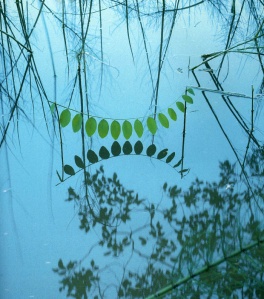 Robinia Leaf Swing: robinia leaf halved, ash twigs, Valle de Sella, Italy,1992
Robinia Leaf Swing: robinia leaf halved, ash twigs, Valle de Sella, Italy,1992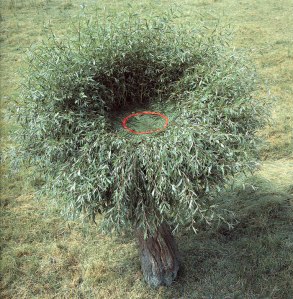
Willow Nest: pollarded willow, hay, fern stalks, poppy petals, Marchiennes Forest, France, 1994
Nils Udo talks about the rhythm of nature in his art, which correlates with his use of line, circles, and patterns.
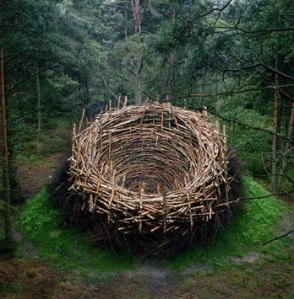 The Nest: earth, stones, silver birch, grass; Lineberg Heath,Germany, 1978
The Nest: earth, stones, silver birch, grass; Lineberg Heath,Germany, 1978
“I associated my existence with the cycles of nature, with the circulation of life. Henceforth my life and work proceeded under the guidance and in keeping with the rhythms of nature. Sensations are omnipresent. I just need to pick them up and release them from their anonymity. Utopias are under every rock, on every leaf, behind every tree, in the clouds and in the wind. The sun’s course on the days of equinox; the tiny habitat of a beetle on a lime leaf; the pointed maple’s red fire; the scent of herbs in a wooded gorge; a frog’s croak in the duckweed; the primrose’s perfume on the banks of a mountain creek; animal traces in the snow; the remaining trajectory of a bird darting through the woods; a gust of wind in a tree; the dancing of light on leaves; the endlessly complex relationship of branch to branch, twig to twig, leaf to leaf.”
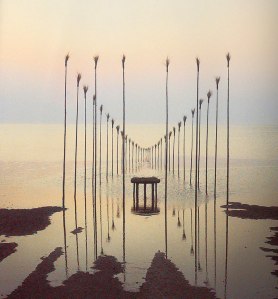 Waterhouse: spruce trunks, birch branches, willow switches and sod on tidal flats– Waddensee mudflats, Holland, 1982
Waterhouse: spruce trunks, birch branches, willow switches and sod on tidal flats– Waddensee mudflats, Holland, 1982
I find Nils Udo’s work to be very inspirational. His techniques and statements about his own work show there are a lot more to site-specific art and installations than just the final piece. It takes a lot of pre-planning and patience to reach his final goals. While his use of line and volume is apparent, Udo’s work is influential to more than just my next project (based on lines.) His reflections and explanations about his work show how every part of the work was planned out and given meaning. He also has a varied use of media and was able to transition from painting to earth sculptures on a much larger scale. His transformation is something he is very aware of, and has documented not only the change within his art, but within his mind as he views the world.
http://www.morning-earth.org/ARTISTNATURALISTS/AN_Nils_Udo.html
